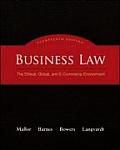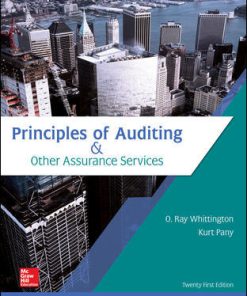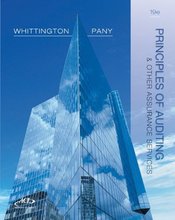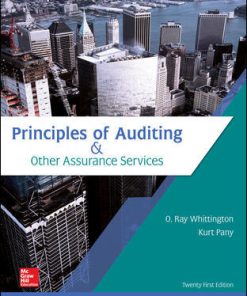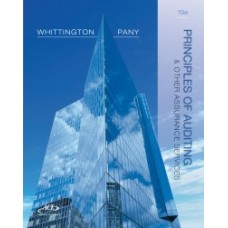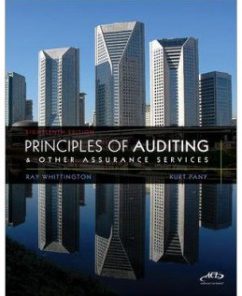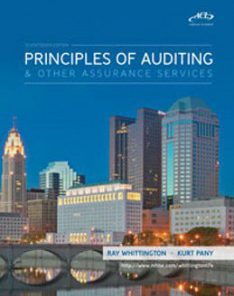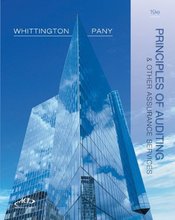Solutions Manual to accompany Principles of Auditing and Other Assurance Services 17th edition 0073379654
$35.00 Original price was: $35.00.$26.50Current price is: $26.50.
Solutions Manual to accompany Principles of Auditing and Other Assurance Services 17th edition 0073379654
Instant download Solutions Manual to accompany Principles of Auditing and Other Assurance Services 17th edition 0073379654 pdf docx epub after payment.

Product details:
- ISBN-10 : 0073379654
- ISBN-13 : 978-0073379654
- Author: Ray Whittington; Kurt Pany
Whittington/Pany’s “Principles of Auditing”, is a market leader in the auditing discipline and the only text in this market which uses the balance sheet approach (vs. the cycles approach). Until October 2002, Ray Whittington was a member of the Audit Standards Board and prior to Ray being on the ASB Kurt Pany was on the board. This has had a major impact on this revision of the text as Whittington has been involved in the audit standards creation process. “Principles of Auditing” presents concepts clearly and proactively monitors changes in auditing making the relationship between accounting and auditing understandable. The 14th edition maintains the organization and balance sheet orientation, while adding and enhancing topics of Risk, Assurance Services, Fraud, E-Commerce, and the latest auditing standards to meet the needs of the current marketplace.
Table of contents:
Chapter 1 The Role of the Public Accountant in the American Economy 1 What Are Assurance Services? 2 The Attest Function 2 Assurance and Nonassurance Services 4 Financial Statement Audits 5 What Creates the Demand for Audits? 6 Major Auditing Developments of the 20th Century 8 The Accounting Profession?s Credibility Crisis 9 Types of Audits 10 Types of Auditors 11 The Public Accounting Profession 12 American Institute of Certified Public Accountants 12 The CPA Examination 14 State Boards of Accountancy 15 Financial Accounting Standards Board 15 Governmental Accounting Standards Board 15 Federal Accounting Standards Advisory Board 15 The Public Company Accounting Oversight Board 15 Securities and Exchange Commission 16 Other Types of Professional Services 16 Organization of the Public Accounting Profession 18 Industry Specialization 19 Responsibilities of the Professional Staff 19 Professional Development for Public Accounting Firm Personnel 21 Seasonal Fluctuations in Public Accounting Work 21 Relationships with Clients 21 Chapter Summary 22 Key Terms Introduced or Emphasized in Chapter 1 23 Review Questions 24 Questions Requiring Analysis 24 Multiple Choice Questions 25 Problems 27 In-Class Team Case 29 Research and Discussion Case 29 Suggested References 29 Chapter 2 Professional Standards 31 Auditing Standards for Public and Nonpublic Companies 32 AICPA Generally Accepted Auditing Standards (GAAS) 32 General Standards?Auditor Qualifications and Quality of Work 33 Standards of Fieldwork?Accumulating and Evaluating Evidence 33 Standards of Reporting 35 AICPA Statements on Auditing Standards (SASs) 35 The Auditors? Responsibility for Detecting Misstatements 37 Errors and Fraud 37 Illegal Acts by Clients 37 The Auditors? Reports 38 The Introductory Paragraph of the Auditors? Report 38 The Scope Paragraph of the Auditors? Report 40 The Opinion Paragraph of the Auditors? Report 40 Other Types of Auditors? Reports 43 Public Company Audit Reports 43 The Attestation Standards 44 Quality Control in CPA Firms 46 Regulation of Accounting Firms 46 Public Company Accounting Oversight Board 46 Peer Review and Inspections 47 International Accounting and Auditing Standards 48 Chapter Summary 49 Key Terms Introduced or Emphasized in Chapter 2 50 Review Questions 51 Questions Requiring Analysis 52 Multiple Choice Questions 53 Problems 54 In-Class Team Case 57 Research and Discussion Case 57 Suggested References 58 Chapter 3 Professional Ethics 59 The Nature of Ethics 60 What Are Ethical Dilemmas? 60 A Framework for Ethical Decisions 60 Making Ethical Decisions?A Professional Example 61 The Need for Professional Ethics 63 Professional Ethics in Public Accounting 64 The AICPA Code of Professional Conduct 64 Analysis of Independence 67 Analysis of Integrity and Objectivity 76 Analysis of General Standards 76 Analysis of Compliance with Standards 76 Analysis of Accounting Principles 77 Analysis of Confidential Client Information 78 Analysis of Contingent Fees 79 Analysis of Acts Discreditable 80 Analysis of Advertising and Other Forms of Solicitation 80 Analysis of Commissions and Referral Fees 81 Analysis of Form of Organization and Name 81 Alternative Practice Structures 81 The CPA as Tax Advisor?Ethical Problems 82 Enforcement of Professional Ethics 83 Ethics for Internal Auditors 83 Chapter Summary 85 Key Terms Introduced or Emphasized in Chapter 3 86 Review Questions 87 Questions Requiring Analysis 88 Multiple Choice Questions 89 Problems 91 In-Class Team Cases 94 Research and Discussion Case 95 Suggested References 95 Chapter 4 Legal Liability of CPAs 97 The Scope of CPA Liability 98 Litigation Placed in Perspective 98 Sources of CPA Liability 98 CPAs? Liability to Their Clients under Common Law 100 The Elements of Duty and Breach of Duty 101 The Element of Losses (Damages) 101 The Element of Causation (Proximate Cause) 101 Auditors? Common Law Liability to Third Parties 102 Ultramares (Known User) Approach 103 Restatement of Torts (Foreseen User) Approach 103 Rosenblum (Foreseeable User) Approach 104 Summary of Third-Party Liability Approaches 104 Liability to Third Parties under Statutory Law 105 Securities Act of 1933 105 Securities Exchange Act of 1934 106 Comparison of the 1933 and 1934 Acts 108 Racketeer Influenced and Corrupt Organizations Act 108 Auditors? Criminal Liability under the Securities Acts 109 Criminal Liability under Other Statutes 110 SEC and Public Company Accounting Oversight Board Regulation 110 CPAs? Liability for Accounting and Review Services 111 CPAs?Posture in the Age of Litigation 112 Chapter Summary 113 Key Terms Introduced or Emphasized in Chapter 4 114 Review Questions 115 Questions Requiring Analysis 116 Multiple Choice Questions 119 Problems 120 In-Class Team Case 123 Research and Discussion Case 124 Suggested References 124 Chapter 5 Audit Evidence and Documentation 125 The Relationship of Audit Risk to Audit Evidence 126 Financial Statement Assertions 126 Audit Risk at the Assertion Level 127 Audit Risk Illustrated 129 Measuring Audit Risk 129 Audit Evidence 130 Types of Audit Evidence 131 Audit Procedures 137 Nature of Substantive Audit Procedures 137 Timing of Substantive Audit Procedures 137 Extent of Substantive Audit Procedures 138 Cost of Audit Procedures 139 Analytical Procedures 139 Nature of Analytical Procedures 139 Timing of Analytical Procedures 142 Extent of Analytical Procedures 143 Audit Evidence for Subjective Areas 143 Evidence on Accounting Estimates 143 Evidence on Fair Market Values 144 Evidence on Related Party Transactions 145 Audit Documentation 145 Confidential Nature of Working Papers 146 Ownership of Audit Working Papers 147 Working Papers and Auditors? Liability 147 Types of Working Papers 148 Organization of Working Papers 150 Guidelines for Preparation of Working Papers 151 Computer-Generated Working Papers 152 Review of Audit Working Papers 152 Chapter Summary 154 Key Terms Introduced or Emphasized in Chapter 5 155 Review Questions 156 Questions Requiring Analysis 157 Multiple Choice Questions 160 Problems 161 In-Class Team Case 167 Research and Discussion Cases 167 Suggested References 168 Chapter 6 Planning the Audit; Linking Audit Procedures to Risk 169 Obtaining Clients 170 Submitting a Proposal 171 Communication with Predecessor Auditors 172 First-Year Procedures 173 Use of the Client?s Staff 173 Other CPAs 174 Arranging for Specialists 174 Engagement Letters 174 Audit Planning 174 Obtaining an Understanding of the Client?s Business and Its Environment 175 Sources of Information 177 Developing an Overall Audit Strategy 179 Audit Risk 183 Assessing Inherent Risks 184 Addressing the Risks of Material Misstatement Due to Fraud 184 Responding to Risks of Material Misstatement 187 Documenting the Audit Planning Process and Risk Assessments 188 Linking Audit Procedures to Risks 189 The Audit Trail 190 Transaction Cycles (Classes of Transactions) 191 Organization of the Audit Program 191 Objectives of Audit Programs 194 General Objectives of Audit Programs for Assets 194 Substantiation of Account Balances 196 An Illustration of Audit Program Design 197 Audit Process 199 Timing of Audit Work 201 Chapter Summary 201 Key Terms Introduced or Emphasized in Chapter 6 202 Review Questions 203 Questions Requiring Analysis 204 Multiple Choice Questions 206 Problems 207 Ethics Case 209 Appendix 6A Selected Internet Addresses 210 Appendix 6B Examples of Fraud Risk Factors 210 Appendix 6C Illustrative Audit Case: Keystone Computers & Networks, Inc. 213 Part I: Audit Planning 213 Appendix 6C Problems 221 Chapter 7 Internal Control 223 The Meaning of Internal Control 224 The Foreign Corrupt Practices Act of 1977 225 Means of Achieving Internal Control 226 The Control Environment 227 Integrity and Ethical Values 227 Commitment to Competence 227 Board of Directors or Audit Committee 227 Management Philosophy and Operating Style 227 Organizational Structure 228 Assignment of Authority and Responsibility 229 Human Resource Policies and Procedures 230 Risk Assessment 230 The Accounting Information System 231 Control Activities 231 Performance Reviews 231 Information Processing Controls 232 Physical Controls 232 Segregation of Duties 233 Monitoring of Controls 234 Limitations of Internal Control 234 Enterprise Risk Management 234 The Auditors? Consideration of Internal Control 235 Obtaining an Understanding of Internal Control to Plan the Audit 236 The Control Environment 236 Risk Assessment 236 The Accounting Information System 236 Control Activities 237 Monitoring of Controls 238 Sources of Information about Internal Control 238 Documenting the Understanding of Internal Control 238 Assessing Control Risk 242 Determining the Planned Assessed Level of Control Risk and Designing Additional Tests of Controls and the Planned Substantive Tests 243 Performing Additional Tests of Controls 243 Reassessing Control Risk and Modifying Planned Substantive Tests 244 Documenting Information on the Assessed Level of Control Risk 245 Decision Aids for Audit Program Modification 245 Consideration of the Work of Internal Auditors 245 Communication of Control-Related Matters 248 Internal Control Reporting by Public Companies and Their Auditors 249 Overall Approach for an Audit of Internal Control 251 Internal Control in the Small Company 253 Chapter Summary 254 Key Terms Introduced or Emphasized in Chapter 7 254 Review Questions 256 Questions Requiring Analysis 257 Multiple Choice Questions 259 Problems 261 In-Class Team Case 264 Appendix 7A Antifraud Programs and Control Measures 266 Chapter 8 Consideration of Internal Control in an Information Technology Environment 269 Nature of IT-Based Systems 271 Characteristics of Various Types of IT-Based Systems 271 Impact of IT on the Audit Trail 273 Internal Control in an IT Environment 275 Organizational Structure of the Information System Function 275 Computer-Based Fraud 277 Internal Auditing in an IT Environment 278 Control Activities in an IT System 278 General Control Activities 280 Application Control Activities 282 User Control Activities 283 Control in Microcomputer Systems 283 The Auditors? Consideration of Internal Control in an IT Environment 284 Obtaining an Understanding of IT-Based System Controls 284 Documenting IT-Based System Controls 284 Assessing Control Risk?Testing IT-Based System Controls 285 Substantive Testing with Computers 289 Using Audit Software: An Illustration 290 Computer Service Centers and Outsourced Computer Processing 290 Chapter Summary 292 Key Terms Introduced or Emphasized in Chapter 8 293 Review Questions 295 Questions Requiring Analysis 296 Multiple Choice Questions 296 Problems 298 In-Class Team Case 300 Chapter 9 Audit Sampling 303 Comparison of Statistical and Nonstatistical Sampling 304 Selecting a Random Sample 305 Other Methods of Sample Selection 307 Stratification 307 Types of Statistical Sampling Plans 308 Allowance for Sampling Risk (Precision) 308 Sample Size 309 Audit Sampling for Tests of Controls 309 Sampling Risk for Tests of Controls 310 Attributes Sampling 310 Determine the Objective of the Test 311 Define the Attributes and ?Deviation? Conditions 311 Define the Population 311 Specify the Risk of Assessing Control Risk Too Low and the Tolerable Deviation Rate 312 Estimate the Expected Population Deviation Rate 312 Determine the Sample Size 312 Select the Sample 314 Test the Sample Items 314 Evaluate the Sample Results 314 Document the Sampling Procedure 315 Detailed Illustration of Attributes Sampling 315 Other Statistical Attributes Sampling Approaches 317 Nonstatistical Attributes Sampling 319 Audit Sampling for Substantive Tests 319 Sampling Risk for Substantive Tests 319 Classical Variables Sampling 320 Mean-per-Unit Estimation 320 Controlling Sampling Risk 320 Determination of Sample Size 321 Evaluation of Sample Results 322 Illustration of Mean-per-Unit Estimation 322 Difference and Ratio Estimation 325 Illustration of Difference and Ratio Estimation 327 Nonstatistical Sampling for Substantive Tests 328 Illustration of Nonstatistical Sampling 328 Chapter Summary 330 Key Terms Introduced or Emphasized in Chapter 9 330 Review Questions 332 Questions Requiring Analysis 333 Multiple Choice Questions 335 Problems 336 In-Class Team Case 339 Appendix 9A Probability-Proportional-to-Size (PPS) Sampling 340 Appendix 9B Audit Risk 345 Key Terms Introduced or Emphasized in Chapter 9 Appendixes 346 Questions and Problems for Chapter 9 Appendixes 347 In-Class Team Case for Chapter 9 Appendixes 348 Integrating Problem for Chapter 9 and the Appendixes 349
People also search:
Principles of Auditing and Other Assurance Services 17th
Principles of Auditing and Other Assurance Services 17th pdf
Principles of Auditing and Other Assurance Services
what are the principles of auditing
|
principles of auditing and assurance services cabrera
|
You may also like…
Solution Manual
Solution Manual for Principles of Auditing and Other Assurance Services, 21st Edition, Whittington
Solution Manual
Principles of Auditing and Other Assurance Services Whittington 19th Edition Solutions Manual
Test Bank
Test Bank for Principles of Auditing and Other Assurance Services, 21st Edition, Whittington
Solution Manual
Test Bank
Test Bank for Principles of Auditing and Other Assurance Services, 18th Edition: Ray Whittington
Test Bank
Test Bank for Principles of Auditing and Other Assurance Services, 17th Edition: Whittington
Solution Manual
Principles of Auditing and Assurance Services Whittington Pany 18th Edition Solutions Manual


